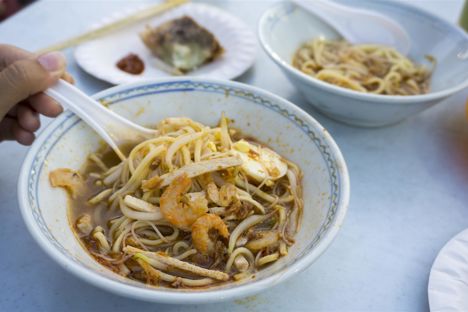
Essential Malaysian store cupboard ingredients
With just a few dry ingredients you can easily recreate authentic Malaysian dishes in the comfort of your own home. Award-winning Malaysian chef, writer and restaurateur Norman Musa shares his top ten store cupboard essentials.
View more from this series:
Store cupboard essentialsMalaysian dishes are among the most delicious in the world, but compared with other Asian cuisines they have relatively little recognition. Heavily influenced by neighbouring countries India, Thailand, China and Indonesia, Malaysian cuisine is an exciting melting pot of flavours. From the fragrant spices of Indonesia to the fiery chillies of Thailand, Malaysian dishes reflect the very best of Southeast Asian cooking.
1. Tamarind
Native to North Africa, the tamarind tree has many useful functions. It’s attractive red wood is used in carpentry, while the fruit is used in traditional medicines and even as a metal polish. In Malaysian cuisine it acts as a souring agent in curries to complement and blend with spicy flavours. Shelf-life for tamarind is normally between a year to two years. Lime or lemon can be used as an alternative but it can easily be kept in reserve in the kitchen cupboard. Norman uses both tamarind paste and pulp in his cooking, which can be easily found in most supermarkets.
2. Dried chillies
Dried chillies are a core ingredient in so many of the great Malaysian dishes such as Rendang curry and Assam laksa. Dried chillies are less sharp than fresh chillies and have a more complex, fruity aroma. Norman recommends buying the largest dried chillies available as they will last longer in the kitchen cupboard. Larger chillies are also less fiery than the smaller varieties, which can be overpowering. Try making your own chilli paste by rehydrating half a dozen chillies in hot water for ten minutes before blitzing with enough water to form a thick paste. Use it by the teaspoon (to taste – every batch will have a different heat level) next time you cook a Malaysian curry.
3. Spices
Malaysian and Indian cultures are so interwoven that the resulting style of cooking has its own name – Mamak. One of the main influences from Indian cuisine is the use of spices that are not typically associated with Southeast Asian cooking. The most common spice mixture is known as the ‘four siblings’, which is a combination of cinnamon, star anise, green cardamom and cloves. This simple spice mixture provides the distinct background flavour found in many Malaysian dishes, although Norman also stocks his cupboard with coriander seeds, fennel and cumin.
4. Lemongrass
This fragrant herb can come dried or fresh, but always try and buy fresh when available. Like dried chillies, lemongrass can either be added whole and removed before serving or blitzed with a little water into a paste. Ten lemongrass stalks (the white bottom half only) blitzed with 150ml of water will make approximately ten teaspoons of paste. Add it to curries and soups for an instant hit of fresh, lemony flavour.
5. Coconut oil
Due to its various health benefits, coconut oil has seen something of a renaissance of late, which is great news when stocking up on Malaysian store cupboard ingredients. ‘I’m so happy it is making a comeback,’ says Norman. ‘I use it when cooking curries, but also for salad dressings. Its high smoke point and subtle tropical flavour makes it perfect for Malaysian stir-fried dishes such as Char kway teow.
6. Creamed coconut
Creamed coconut blocks are made from the unsweetened, dehydrated flesh of a mature coconut, ground to a semi-solid white creamy paste. Sold in the form of a hard white block, it can be stored at room temperature. One of the essential ingredients in Malaysian curries, it is also used to enrich sauces, soups and traditional desserts such as cendol. Storing leftover coconut milk in its tin can be a waste if you only use a little bit after opening it. To avoid wastage, Norman recommends freezing any remaining coconut milk in ice cube trays. One cube is equivalent to a tablespoon of coconut milk.
7. Kecap manis
This sweetened, syrupy soy sauce is one of most distinct flavours in Malaysian cooking. It is made by reducing dark soy sauce with sugar, garlic, galangal and bay leaves. There are two distinct types, sweet and salted, which are often combined for the perfect balance of flavour. Norman opts for Habhal's Kecap Kipas Udang when he cooks, although many other brands can be found in Asian supermarkets. Malaysian Massaman beef curry is one of the most common uses of kecap manis, but it is also used in dipping sauces and marinades.
8. Dark coconut sugar
Similar to palm sugar, dark coconut sugar is an essential ingredient in many curries and Malaysian sweets and is said to be more nutritious than standard granulated sugar. Manufactured from the sap of the flower buds of coconut trees, the sugar has a rich, caramel flavour, although the taste can vary depending on the variety of coconut. If unavailable, jaggery or palm sugar make excellent alternatives.
9. Dried noodles
A staple across Asia, few ingredients are as convenient as dried noodles – so much so the Japanese famously voted instant ramen as the country’s best invention of the twentieth century. Faster to cook than rice and just as versatile, dried noodles are most prevalent in Malaysian Chinese cuisine, where they are used in salads, soups, curries and many stir-fried dishes.
10. Jasmine rice
Norman prefers using jasmine rice over basmati due to its wonderful floral aroma and comforting fluffy texture. Incredibly versatile, jasmine rice makes a delicious accompaniment to most curries and stir-fries. Avoid soggy, overcooked rice and learn how to achieve the perfect fluffy finish with our foolproof how to guide.
List provided by Norman Musa, author of Amazing Malaysian: Recipes for Vibrant Malaysian Home Cooking (Square Peg)


